Historical Snapshots 1940 - 1960s
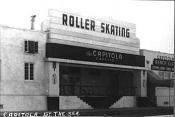
Roller Skating Rink, in the 1940s
Capitola's Roller Rink was built on the site of the grand old Capitola Hotel in 1933. Two years later, several newly built structures including a dance hall were moved from the vicinity of Capitola Avenue and Stockton Street, and combined with the roller rink to create the Capitola Ballroom. The ballroom was renovated in 1954 to become The Saba night club. Like the original hotel, The Saba burned to the ground in 1957.
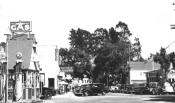
Downtown Capitola, ca. 1940
A photograph of Capitola Avenue toward Depot Hill, circa 1935. The newly completed post office is marked by the flag. The liquor stores at left appeared at the end of Prohibition. The gas station marks the intersection of Capitola Avenue and Stockton Street.
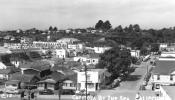
Capitola Village, circa 1945
By 1945, Capitola had much the same appearance as it does today. The Esplanade advertised the pleasures of the Capitola Amusement Company and the Edgewater Bar. Real estate offices were anchored at the corner of Capitola and Monterey avenues, offering cottages for rent and lots for sale.
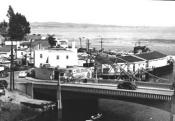
Bridge into Capitola, ca. 1948
This view of Capitola, taken about 1948, shows one of several giant slides that were popular in the lagoon over many years. Most were eventually destroyed by storms.

Capitola City Council, 1949
Brad Macdonald, 27 (far left), was the popular choice for the city's first mayor in 1949, but the council appointed Harlan P. Kessler (fourth from left) in a surprise move that nearly led to a riot and christened the new city "Scrapitola." The Council posed later that year in front of the earliest city hall at 140 Monterey Avenue.
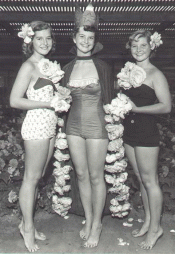
The First Capitola Begonia Festival Queen & Her Court
Jeanette Hayford and her sisters, Caroline and Barbara
During the first few years after incorporation, Capitola searched for a perfect summer pageant to showcase the new municipality and its prospects for the future. The annual Capitola Begonia Festival became the ideal event, featuring begonias from the neighboring Vetterle, Antonelli and Brown bulb ranches. Begonias fastened to surfboards and barges in the 1950s were eventually replaced by more elaborate floats. Today, the floats that parade down Soquel Creek each September are often accompanied by theme music and brief theatrical performances.
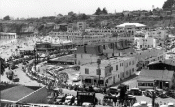
Capitola Celebrates the Fourth of July, 1955
Capitola held an annual "Gay Nineties Day Parade" from the time the city incorporation effort began in 1948 until the Begonia Festival took over as the city's favorite event in 1955. Andy Antonetti's merry-go-round, next to the Bandstand on the Esplanade, pleased youngsters every summer from 1955 until the beach disappeared after construction of the Santa Cruz Small Craft Harbor in 1964.
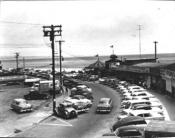
Capitola's Esplanade, ca. 1957
Capitola's Esplanade was expanded to curve out onto the beach in 1925. This photograph was taken thirty years later, in 1955, and shows its popular feature of the era--Andy Antonetti's merry-go-round. The ride is still in existence, now located at the Red Barn on Highway 101.
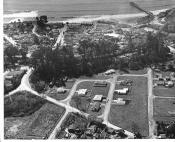
Aerial view of the Coastline, ca. 1964
Bay and Monterey Avenue are in the foreground. The view illustrates how Capitola lost its beach after the Santa Cruz Small Craft Harbor was completed in 1964. Work was successfully completed to restore the beach in 1969-70.
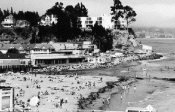
Capitola Beach, late 1960s
When the Santa Cruz Small Craft Harbor was completed in 1964, the jetty blocked sand that had previously drifted down the coast to replenish the Capitola beach. The city suffered without its best visitor attraction until the Army Corps of Engineers built a 250-foot breakwater at the each end of the beach in 1969.
